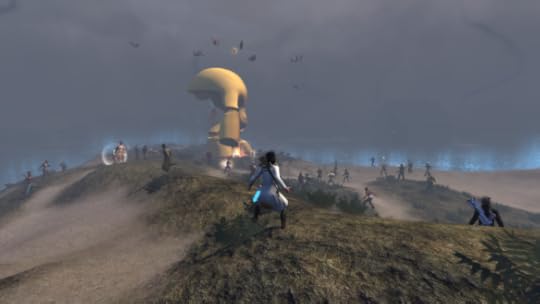Tyler F.M. Edwards's Blog, page 67
December 15, 2014
TSW: The Great Tokyo Nerf and the Second Serpent
A few days ago, I did a big post summarizing the state of The Secret World’s Tokyo zone six months after its launch. But fate likes to mock me, because Funcom wasn’t done making big changes to Tokyo. Shortly after I published that post, they published sweeping changes intended to retune the difficulty of Tokyo and make it more approachable for the average player.
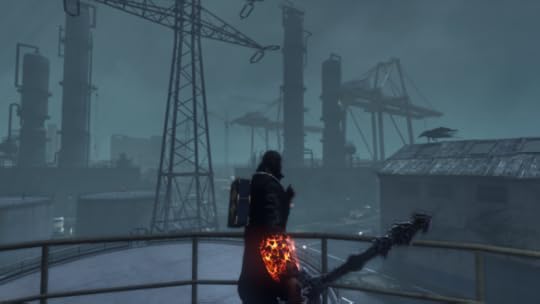 Virtually every enemy in Tokyo has now received an across the board nerf of approximately 10%. That is, 10% less damage, health, and shields. In addition to that, many quests now award low level AE capacitors and AEGIS modules, and the sequin cost of AEGIS upgrade kits has been massively reduced.
Virtually every enemy in Tokyo has now received an across the board nerf of approximately 10%. That is, 10% less damage, health, and shields. In addition to that, many quests now award low level AE capacitors and AEGIS modules, and the sequin cost of AEGIS upgrade kits has been massively reduced.
Despite all the wailing and gnashing on teeth on the forums about “easy mode,” I haven’t found this change to make an enormous difference. It’s noticeable, but it’s not a “to the ground” situation. Things that were challenging before are still challenging — just slightly less so — and things that were easy before are still easy — just slightly more so.
I think what ultimately might be more meaningful is that you can now get a full set of AEGIS gear without trading with other players or grinding until your eyes bleed. This erases my last major complaint about AEGIS, and it should make things a lot less painful for players just entering the zone. A full set of AE capacitors makes a big difference.
Naturally, these changes are quite controversial — according to the MMO community, nothing is ever hard, and any nerf is a grave injustice — but for my part, I think these are positive changes.
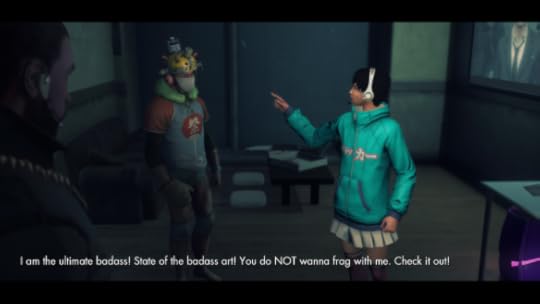 I wasn’t really struggling in Tokyo myself, but I’m over-geared, and I have one of the better solo builds around. And even then, it was still a challenge for me. It seems to me the intended audience for Tokyo — newish players fresh from Transylvania in a motley of greens, blues, and issue purples — would get wrecked pretty hard. Even after the nerf, they’re probably still in for a bit of bumpy ride to start.
I wasn’t really struggling in Tokyo myself, but I’m over-geared, and I have one of the better solo builds around. And even then, it was still a challenge for me. It seems to me the intended audience for Tokyo — newish players fresh from Transylvania in a motley of greens, blues, and issue purples — would get wrecked pretty hard. Even after the nerf, they’re probably still in for a bit of bumpy ride to start.
For me, the biggest positive of the change is that I’m actually enjoying exploring Tokyo now. Before, the fights were too long and brutal for me to want to do much beyond my mission objectives. Now I’m looking into every nook and cranny for lore and missed item missions, as I did in the past zones. It’s given me a much greater appreciation for the care and craftsmanship that went into Tokyo.
Now if only they would do something about the mob density in Orochi Projects…
In other news, I’m certifiably insane.
Enter the Dragon (again):
Most would agree there is very little use for alts in TSW. You can gain every ability and experience the overwhelming majority of content on a single character. If you’re a hopeless completionist or story-hound, you might want to create one character for each of the three factions to experience their storylines.
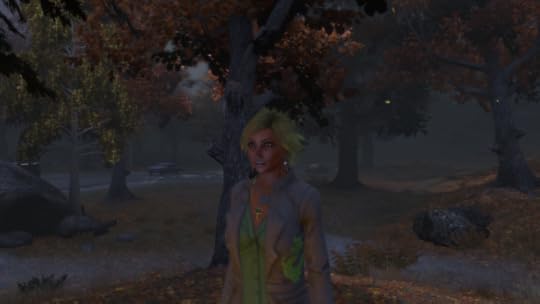 I now have a fourth character, and I am therefore completely insane.
I now have a fourth character, and I am therefore completely insane.
But what I can say? I love the Dragon. They’re a constantly unfolding riddle, an eternal challenge to your own expectations. They’re endlessly fascinating, and it had been a very long time since I played through their faction content, so I wanted to experience it all again.
Plus, like many altoholics, I think I’m just addicted to that “new character smell.” There’s always a certain thrill to creating a new character and thinking of all the epic adventures that lie ahead, even if it’s all stuff you’ve seen before.
Of course, being me, I spent the first several hours of the new Dragon’s life combing through Pangaea and the cash shop to put together a variety of different outfits for her. I partially modeled her appearance after Nilin from Remember Me, so I did my best to put together a cosplay of that character.
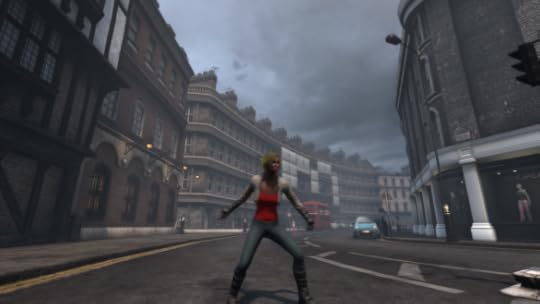 For the most part, though, I’m going to stick with a Dragon-themed outfit I put together that I think is quite stylish.
For the most part, though, I’m going to stick with a Dragon-themed outfit I put together that I think is quite stylish.
I’m planning to use fist weapons as her main weapon. I don’t regret switching to blades on my main, but I still have a soft spot for fists, so I’m giving them another go and hoping to stick with them this time. I really enjoy the animations for fist abilities; they have a great feral intensity to them.
For my second weapon, I waffled between chaos and elemental magic. Right now, I’m trying elemental, but I may change my mind later. I picked it because it looks cooler than chaos, I like combining ranged and melee, and I’d never heard of anyone going fist/elemental. I don’t think it’s really that crazy of a combination — I’m actually rather surprised I don’t see people using it — but it’s uncommon enough to make me feel pleasantly hipsterish.
I’m not sure what my long term plan is for the character. I’d like to play through the launch story, but I might move on after that. I’m already splitting my endgame attention between my original Dragon and my Templar. I don’t really need a third character running around Tokyo.
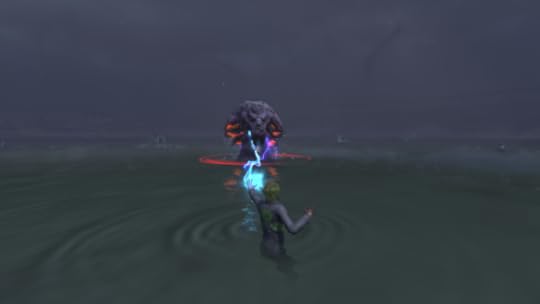 But for now, I’m enjoying playing through everything again.
But for now, I’m enjoying playing through everything again.
Filed under: Games Tagged: fantasy, The Secret World

December 12, 2014
World Spectrum Holiday Sale 2014
To celebrate the holiday season, I am once again holding a sale on my World Spectrum series of science fantasy epics. From now through Boxing Day, all three books in the series — Rage of the Old Gods, Children of the Gods, and Human Again — will be 50% off at Smashwords when using the appropriate coupon code.
Humanity was not born free.
Long ago, humans were slaves to the Old Gods. They rebelled, overthrowing the Gods and establishing their own societies, but peace did not last. Humanity slaughters itself in petty wars.
Now, an army of war Automatons threatens to destroy the land of Eastenhold. To save her people, a young woman named Leha travels to the to the lost worlds of Tyzu and Sy’om, whose alien powers defeated the Old Gods in ancient times.
But there is worse to come. The wars of humankind only hasten the Old Gods’ return, and even Leha’s newfound powers may not be enough to save her people from the Gods’ fury, or from the hatred in their own hearts.
* * *
If you’ve been enjoying my free chapters of Rage of the Old Gods, now is the perfect time to buy the full book and save yourself waiting for the next chapter.
Curling up with your ereader for some epic adventure is a nice way to take a load off after all the stress of holiday shopping, and Smashwords ebooks are DRM free, so you can also purchase them and then send them to friends as gifts. A great choice for any readers or fantasy fans on your shopping list.
Here’s how it works:
Copy the appropriate coupon code below, click the buy link on the book’s Smashwords page (accessed via the links below), and input the code when prompted to receive the discount.
Rage of the Old Gods code:
JN75C
Children of the Gods code:
UA52X
Human Again code:
WB73W
Codes are not case sensitive.
Please note that these discounts only apply to purchases through Smashwords. You will not receive any discount on purchases made through other retailers. But do keep in mind that Smashwords provides ebooks in all major formats, so you should be able to enjoy my books regardless of your preferred reading device.
Also note that these codes will cease to function on December 27, so make sure to take advantage now.
If you’d like to learn more about the series before you buy, check out the official site for oodles of back information, reviews, author interviews, and bonus material.
Happy holidays!
Filed under: My writing, World Spectrum Tagged: books, fantasy, sci-fi, steampunk, The World Spectrum, writing

December 9, 2014
Continuum Renewed for Final Season
For a while now, Continuum fans have been in limbo, with no word of whether the show would be renewed or cancelled. The third season ended many months ago, yet there was no word on a fourth season, if any.
 At long last, the wait is over, and it’s both good news and bad news.
At long last, the wait is over, and it’s both good news and bad news.
The good news is Continuum will return for a fourth season. The bad news is that it’s the final season, and it will only be six episodes. It’s not so much a new season as it is a mini-series to wrap up the show’s story.
But at least we will get a proper ending. Far too many sci-fi shows have been left hanging without a satisfactory end. I even went so far as to say part of me wished the show had ended with the third season finale, purely because I worried we would never get a proper conclusion.
A mere six more episodes is nowhere near the four more seasons the show’s creator wanted, but it’s definitely better than nothing. And to be perfectly honest, as much as I love Continuum, I’m not sure there was enough potential story in the concept to carry it that long. It deserves more than just six more episodes, but seven seasons was always a bit pie-in-the-sky, for more reasons than one.
But in the greater scheme of sci-fi’s struggle on television, this is still a win. Six episodes is less than any fan would want, but it’s far better than no ending at all. Kudos to Showcase for letting us all have closure.
 For my part, I look forward with glee to the final season, even as I wish for more. Every season of Continuum has been a marked improvement over the one before it. Given the utterly stellar conclusion to the third season, I can only imagine the final episodes will be nothing short of spectacular.
For my part, I look forward with glee to the final season, even as I wish for more. Every season of Continuum has been a marked improvement over the one before it. Given the utterly stellar conclusion to the third season, I can only imagine the final episodes will be nothing short of spectacular.
I suppose now would be a good time to begin speculating on what Continuum’s conclusion will look like.
Personally, I hope we don’t see some fairy tale ending where Kiera gets her future back and lives happily ever after with her son and her husband. Such a positive conclusion has its appeal, but it would waste the character development surrounding Kiera letting go of her future, and her husband was kind of a jerk anyway. Plus, it’d be a bit awkward, what with the whole Brad situation.
I get the feeling Kellogg is probably going to die. Alec was certainly giving him the death stare at the end of last season, and I don’t think six episodes is enough time to give him a proper redemption story.
I have a feeling their ultimate goal is to have Alec and Julian cooperate to create a better future, but I’m not sure how I’d feel about that. The problem is Julian has been portrayed as so nasty for so long that it’s going to be very hard to accept him as anything but a self-serving douchecanoe.
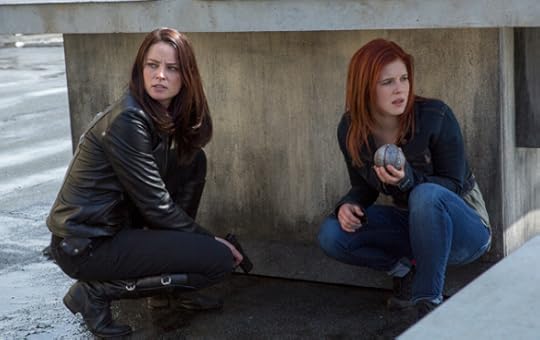 I hope Carlos gets some time to shine. He’s a pretty good character, but he’s always playing second fiddle. He deserves his moment to be the hero. I also hope we get to see Emily being badass some more, if only because I like Magda Apanowicz.
I hope Carlos gets some time to shine. He’s a pretty good character, but he’s always playing second fiddle. He deserves his moment to be the hero. I also hope we get to see Emily being badass some more, if only because I like Magda Apanowicz.
Filed under: Misc. Tagged: Continuum, sci-fi, TV

December 6, 2014
TSW: Tokyo Six Months In
Issue #10 has arrived in The Secret World (far sooner than anyone expected), and the Tokyo storyline is nearing completion. It’s been six months now since the game’s first post-launch zone arrived with issue nine, and I thought now would be a good time to look back at how Tokyo has evolved in that time.
 First, I’ll give my impressions on issue #10, and then I’ll discuss Tokyo as a whole.
First, I’ll give my impressions on issue #10, and then I’ll discuss Tokyo as a whole.
Nightmares in the Dream Palace:
If I was to describe issue #10 in one word, I’d go with “solid.” It hasn’t blown me away, but it’s largely well-executed and enjoyable.
The story picks up immediately where issue nine left off, with players in hot pursuit of the White Rabbit killer. The chase takes you beyond the first quarantine wall and into new areas of Tokyo. It culminates with a journey into the past of John, the disturbed man who became the voice of the Zero Point Pathogen.
I think the most memorable elements of issue #10 for me were the environments, and that’s both a positive and a negative.
The negative is the Orochi Projects suburb. That place is Hellish to try and play in. Twisting streets, no room to maneuver, and the most insanely dense mob placement in the game make for a miserable slog. It’s impossible to take two steps without being dog-piled by a huge crowd of mobs.
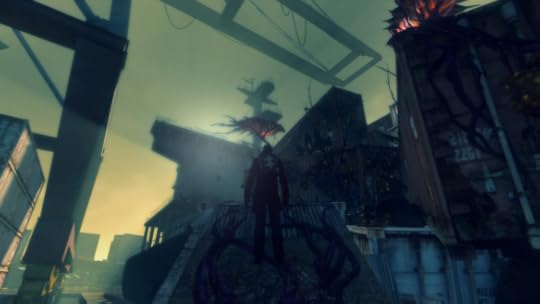 On the other hand, the other new areas — the Filth-ridden docks and an abandoned CDC camp — are easily the best areas in Tokyo to date. They’re incredibly detailed, and they have a beautifully haunting post-apocalyptic feel. It hammers home the unstoppable nature of the Filth to wander through a CDC camp full of raging zombies in hazmat suits. Meanwhile, the fungal Filth have turned the docks into a surreal nightmare landscape that contrasts wonderfully with the sterile nature of the rest of Tokyo.
On the other hand, the other new areas — the Filth-ridden docks and an abandoned CDC camp — are easily the best areas in Tokyo to date. They’re incredibly detailed, and they have a beautifully haunting post-apocalyptic feel. It hammers home the unstoppable nature of the Filth to wander through a CDC camp full of raging zombies in hazmat suits. Meanwhile, the fungal Filth have turned the docks into a surreal nightmare landscape that contrasts wonderfully with the sterile nature of the rest of Tokyo.
Of the new characters, I find Ricky Pagan’s old flame, Kaoru, the most compelling. The Phoenicians have so far been consistently portrayed as unambiguously evil, so it’s interesting to see someone with a totally different perspective of them.
I still think she’s wrong, of course. In fact, I’d like to see how she would react when confronted with the true brutality of her employers. Not that the rest of the societies are much better…
Kaoru is also the first transgender character I can recall seeing in a video game. I’m not sure whether to praise that or not, considering her status as a Phoenician agent nominally puts her in the “villain” category — though she does seem awfully nice.
On the plus side, it is a mark in Funcom’s favour that — as is the case for the game’s many other LGBT characters — her sexual identity isn’t the entirety of her character. She comes across as a real, multifaceted person, not just “token transgender girl.”
 Overall, I enjoyed issue #10, and beyond the frustration of navigating the Projects, I have no major complaints. It just feels a little by the numbers. The mission design is still wildly original compared to other MMOs, but it’s nothing TSW players haven’t seen before. Solve some cryptic riddles, evade some devilish traps, fight some unspeakable horrors, and cap it all off with a surreal dream sequence that will twist your mind into pretzels.
Overall, I enjoyed issue #10, and beyond the frustration of navigating the Projects, I have no major complaints. It just feels a little by the numbers. The mission design is still wildly original compared to other MMOs, but it’s nothing TSW players haven’t seen before. Solve some cryptic riddles, evade some devilish traps, fight some unspeakable horrors, and cap it all off with a surreal dream sequence that will twist your mind into pretzels.
Could have used some more reveals, too. Issue #10 told us very little most fans hadn’t already inferred from the many available hints. On the plus side, it was good to see Lilith hasn’t been forgotten after all.
I wouldn’t say I’m disappointed in issue #10. I’m just not blown away, either.
TSW doesn’t really do bad content. There’s just awesome, and less awesome.
With issue #10, Tokyo is now mostly finished as a zone. There’s still the final showdown at Orochi Tower and the new lair in issue #11, and we might get some more Sidestories packs, but the meat of the zone is past us. Now seems a good time to take stock of how Tokyo has turned out.
Content:
A big problem with Tokyo at launch was how empty it was. It is true that issue nine was still the largest content update to date at its release, but it’s obvious the zone was very unfinished. We had one half of a main storyline, and little else.
 That is no longer a problem. With two issues and two Sidestories packs, Tokyo is now roughly as big and as fleshed-out as the previous zones. Those going through Tokyo now will find a much meatier, more diverse, and more enjoyable journey than those who played at launch.
That is no longer a problem. With two issues and two Sidestories packs, Tokyo is now roughly as big and as fleshed-out as the previous zones. Those going through Tokyo now will find a much meatier, more diverse, and more enjoyable journey than those who played at launch.
It’s not just a matter of more missions, though that obviously makes the biggest difference. Many minor visual and environmental tweaks to Tokyo have made it much more believable as both a city and a disaster area.
It is difficult to escape the conclusion that those of us who played in Tokyo from the start have been in a paid beta. The developers didn’t really have any other option, to be fair; making fans wait much longer would have been financial suicide. It’s just a shame it had to work out this way.
The plus side is that problem has now been solved. Tokyo no longer feels like an unfinished product in need of completion. It feels like a solid experience in its own right that will only be enhanced by further updates.
The only “problem” now is that you need to make four separate purchases to get the full Tokyo experience — with more on the way — but the total cost is comparable to an expansion for any other game. Hopefully Funcom will put out a “Tokyo complete pack” or something to simplify matters.
 If you play TSW and have not yet entered Tokyo, I strongly recommend buying all content packs before you go there. You will have much more fun seeing the whole picture at once than nibbling away at it piecemeal.
If you play TSW and have not yet entered Tokyo, I strongly recommend buying all content packs before you go there. You will have much more fun seeing the whole picture at once than nibbling away at it piecemeal.
And trust me, the quality of the content makes it utterly worthwhile. Tokyo is the most unrelenting dark and disturbing area of TSW to date, but also the most powerful. Here, more than any other, you realize what is at stake in the conflict with the Dreamers. You will have your mind bent by horrors and wonders beyond comprehension, but you will also see the human toll of the Filth’s madness.
It also features some of TSW’s greatest characters to date in the form of Daimon Kiyota and Ricky Pagan, both of whom are monuments to the game’s impeccable writing, and some wonderfully creative mission mechanics. Who doesn’t want to fight the Filth with the awesome power of rockabilly?
AEGIS:
The other main problem with Tokyo at launch came from the frustrations associated with the new AEGIS system. Those flaws haven’t vanished entirely, but they have been heavily mitigated. Kudos to Funcom for taking all the feedback to heart and acting swiftly to make changes.
The biggest difference comes from the skill lines to improve your mastery of AEGIS. I’m particularly grateful for the ability to largely trivialize the global cooldown triggered by swapping controllers. I’d rather the cooldown have been removed altogether, but this is a vast improvement over the original incarnation of the system.
 Sequin and research data rewards from missions have also been vastly increased — especially for first time players — which makes the grind to level AEGIS a lot more bearable. It will still take an enormously long time to fully max out all AEGIS gear, but you can at least make progress at a decent clip now, and it doesn’t take long to have enough AEGIS power to make the shields on open world mobs a non-issue.
Sequin and research data rewards from missions have also been vastly increased — especially for first time players — which makes the grind to level AEGIS a lot more bearable. It will still take an enormously long time to fully max out all AEGIS gear, but you can at least make progress at a decent clip now, and it doesn’t take long to have enough AEGIS power to make the shields on open world mobs a non-issue.
AEGIS is still something of a baptism by fire for players first entering the zone, and I’d still prefer it everyone got a full set of gear to start, but it’s not hard to get past that painful initial phase, especially if you remember to buy yourself four QL0 AE capacitors before entering the zone.
In short, AEGIS is still a tad frustrating, but only at first, and it takes little time to reach a point where you hardly notice it’s there.
I’m also pleased to report issue #10’s introduction of AEGIS shields for players is far less painful than the first stumbling steps of the main system. Shields are far simpler and less grindy than the rest of AEGIS, and mobs do so little AEGIS damage that the shields hardly even matter. I suspect the only people who are going to much care about the shields are tanks doing AEGIS group content, once that’s added.
Filed under: Games Tagged: fantasy, The Secret World

December 3, 2014
Off Topic: On the Subject of Me
I don’t really talk much about myself on this blog. This is a conscious decision; I decided going in that this blog was about awesome things like sci-fi, fantasy, video games, and writing. By comparison, I’m pretty boring. This is my blog, but it’s not about me, per se.
 However, I’ve been posting here multiple times per week for over three years now, so perhaps it’s time I let the readers get to know me at least a little bit.
However, I’ve been posting here multiple times per week for over three years now, so perhaps it’s time I let the readers get to know me at least a little bit.
I now present you with a rambling list of fun facts about me, presented in no particular order.
On the subject of me:
I have never set foot outside of Canada, but I have looked out across the Atlantic from the tip of Cape Spear, gone on road trips so far into Quebec no one around spoke English, crossed the Straight of Juan de Fuca by ferry, and hiked in the old growth rainforests of British Columbia.
My favourite colour is purple.
My favourite band is Metric, but my favourite song is King and Lionheart by Of Monsters and Men, and if I was to pick a song to be “theme song of my life,” I’d go with All These Things That I’ve Done by the Killers.
The song I want played at my funeral, however, is Invincible from World of Warcraft. That or Help, I’m Alive by Metric, purely for the irony.
I have trouble picking a favourite television show. It’s sort of a toss-up between Star Trek: Enterprise, The Simpsons, and Futurama.
My favourite book and my favourite movie are one and the same: The Lord of the Rings trilogy. I might as well count them all as a single volume, since I can’t pick a favourite from the trilogy.
My favourite video game character is Jim Raynor. I don’t believe I could pick a single favourite character from books or television. Candidates from literature include Cryl-Nish Hlar, Xervish Flydd, Seda, R.M. Dahl, Michael Liberty, Samwise Gamgee, Remus Lupin, and Kellen Tavadon. Candidates from television include Jean-Luc Picard, William Adama, Hoshi Sato, Dr. Phlox, Quinn Fabray, Bert Hummel, Karl “Helo” Agathon, and Dr. Zoidberg.
Similarly, I love food far too much to ever settle on a favourite meal. Potato roti could be a strong candidate, as would be aloo chole with puri. My father also makes surprisingly good falafel for a WASP, so that could be in the running. Or maybe a bowl of sambar with a nice side of naan…
My favourite sound is wind blowing through the trees.
My all-time favourite video game is Warcraft III. My current favourite game is The Secret World.
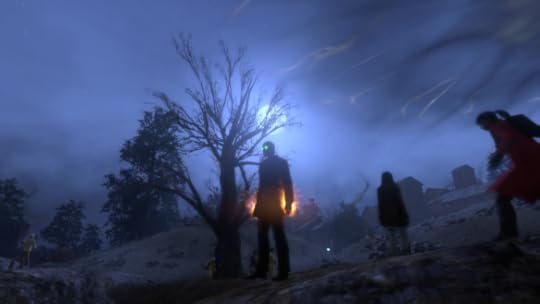 My favourite time of year is winter, though autumn is a very close second. I despise springtime, and I have little love for summer.
My favourite time of year is winter, though autumn is a very close second. I despise springtime, and I have little love for summer.
I have only ever broken one bone: my skull. I leaped out of my mother’s arms as a baby and fell head-first onto a concrete floor. I am apparently lucky to be alive, and luckier still to have suffered no brain damage as a result. I was so young at the time that I have no memory of any of it.
I am neither a dog person nor a cat person. I am a rat person.
In the past, I ran the international campaign to save Star Trek: Enterprise for several years. This is the same campaign that held large public rallies and raised several million dollars to fund a new season (unsuccessfully), though such heady days were long past by the time I took over. I mostly just organized letter-writing campaigns and publicity drives for our petition.
The worst movie I ever saw was the remake of Bewitched starring Nicole Kidman and Will Ferrell. Having my testicles electrocuted for ninety minutes would have been less painful.
The happiest I can ever remember being was reading Harry Potter and the Order of the Phoenix in bed on the eve of my fourteenth birthday, as a thunderstorm raged outside. This could be interpreted as a sad commentary on my life to date.
 I have never set foot in a church.
I have never set foot in a church.
I stole the name of this post from a Kids in the Hall sketch.
I have not cut my hair in nearly fifteen years. It’s not as long as you might think, though.
I am of primarily British and Nordic descent, meaning there is an excellent chance that, 1,000 years ago, my ancestors on one side of the family were raiding my ancestors on the other side of the family.
I am a chronic insomniac. Sleep is for the dead.
Filed under: Misc. Tagged: Off topic

November 30, 2014
Skyforge: I Want to Believe
It’s been a while since there have been any upcoming MMOs I’ve been really excited about. Guild Wars 2 was probably the last, since I didn’t know much about The Secret World until it had already launched.
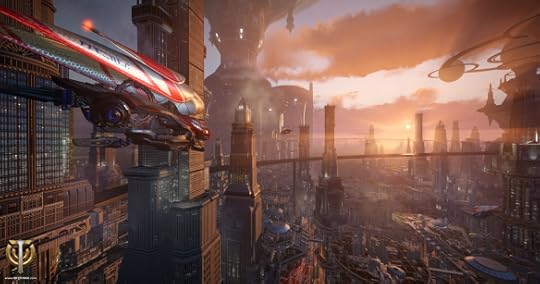 Of the upcoming crop, there are some that I have some curiosity about, but only one that has properly intrigued me: Skyforge, a science fantasy free to play title due for release soonish.
Of the upcoming crop, there are some that I have some curiosity about, but only one that has properly intrigued me: Skyforge, a science fantasy free to play title due for release soonish.
The previews for Skyforge are hitting a lot of the right notes for me — free to play from the start, action combat, gorgeous graphics, unique setting, multiclassing — but there are also some serious causes for concern that keep me from getting properly excited.
God mode:
The setting for Skyforge seems pretty interesting, though I haven’t seen a lot of info about its lore, leading me to believe it may not be a priority for the developers. It’s science fantasy rather than the traditional high fantasy of other MMOs; it is set in a world full of magic and mystery, but also advanced technology.
Some zones in Skyforge are the sort of pastoral wildernesses you see in most MMOs, but others are grandiose sci-fi metropolises that look like something straight out of Star Wars. It’s a pretty interesting mix, and as anyone who has read my books knows, I’m rather keen on the science fantasy/magitech angle.
The concept of godhood is important in Skyforge. The main threat in the game comes in the form of invasions by evil gods seeking to claim the world as their own, and players take on the role of immortals who will eventually ascend to godhood.
 I initially thought this was a fairly meaningless title meant to cater to players’ egos, but from the sounds of it, becoming a god will actually have an impact on gameplay, as well. There’s mention of players being able to literally enter god mode, granting them fantastic powers, such as the ability to change classes even in combat.
I initially thought this was a fairly meaningless title meant to cater to players’ egos, but from the sounds of it, becoming a god will actually have an impact on gameplay, as well. There’s mention of players being able to literally enter god mode, granting them fantastic powers, such as the ability to change classes even in combat.
That brings me to what is currently the thing I find most compelling about Skyforge: its unusual progression model and potential for multi-classing.
It sounds a bit like a combination of the systems in The Secret World and Rift. Skyforge does not have levels in the traditional sense, though it does have pseudo-levels like TSW, and you can unlock every class in the game on a single character, switching between them at will.
If you know me, you know I’ve never liked being pigeon-holed into a single class or role, so this is very appealing to me. It is a little disappointing that you can’t blend the abilities of different classes, and more disappointing that classes are unlocked in tiers, so some will require significant grinding to unlock, but still much preferable to a traditional class system.
As for the classes themselves, the ones I’ve seen so far seem fairly generic — berserker, paladin, cryomancer, etc. — but there will supposedly be about a dozen total, with more released after launch, so there’s plenty of room for some more original class concepts, especially considering the potential opened up by the combination of sci-fi and fantasy elements.
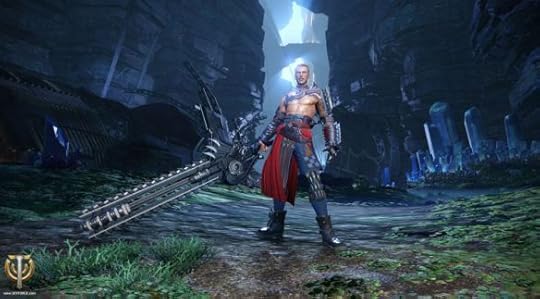 The classes also seem more powerful, spectacular, and pleasantly over-the-top than their equivalents in other MMOs. I generally have no interest in warrior-style classes, but after seeing the berserker trailer, in which said class ran around sawing giants in half with a chainsaw-greatsword, I have a strong urge to make an exception to my “no warriors” rule.
The classes also seem more powerful, spectacular, and pleasantly over-the-top than their equivalents in other MMOs. I generally have no interest in warrior-style classes, but after seeing the berserker trailer, in which said class ran around sawing giants in half with a chainsaw-greatsword, I have a strong urge to make an exception to my “no warriors” rule.
In doing research for this post, I have also discovered that Skyforge will apparently lack the traditional holy trinity, which is also compelling. There are no direct healing classes, though there are supposedly classes that provide support other ways, and there may be tanks — it’s not entirely clear.
One issue with Skyforge is that it hasn’t been getting a lot publicity for whatever reason, so it’s hard to find reliable information on it. Another tidbit that has popped up in my research for this post is that content will supposedly scale up to your character’s level, much like in Guild Wars 2, which is also welcome news.
So taken altogether, that’s very nearly my MMO wishlist summed up in a single title, minus only a strong commitment to story. But yet there are some things about Skyforge that give me serious pause.
A poor pedigree:
Most of my concerns about Skyforge are based on who’s developing it: the same team behind Allods Online.
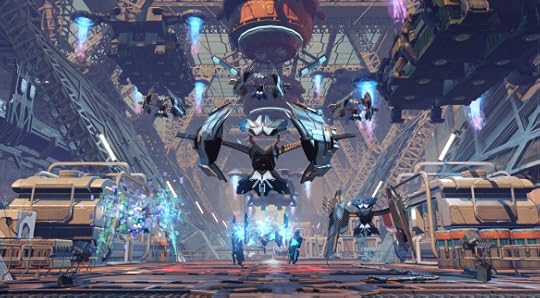 Allods Online. Those are two words to send a chill down the spine of any MMO player.
Allods Online. Those are two words to send a chill down the spine of any MMO player.
Now, I have not played Allods myself, and for what it’s worth, I have heard it’s actually a pretty solid WoW clone, as these things go, in terms of general game mechanics.
However, it was for a very long time the poster child for how not to do free to play — these days Star Wars: The Old Republic may have taken that crown. Much of the negative views of free to play in the west have their roots in Allods. It took ruthless monetization and pay to win to mind-bogging heights.
Now, many postulate that a lot of that was the doing of the publisher, not the developers, so there may still be hope for Skyforge, since it will have a different publisher.
There’s more than past history that makes me a little weary of Skyforge, though. There’s also the fact that the Allods team is based in Russia, and due to recent world events, I’m leery of playing a Russian game.
Between their militaristic aggression and brutal anti-gay laws, it’s safe to say Russia isn’t my favourite country right now. I generally make it a point not to judge a country by the actions of its government, but by all reports, those policies are pretty popular among the Russian people.
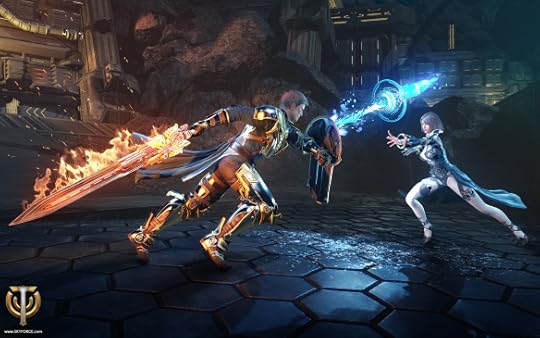 On the other hand, it doesn’t seem fair to assume the worst of the Allods people. Just because their country currently has a surplus of homophobic thugs doesn’t necessarily mean they’re counted among that number.
On the other hand, it doesn’t seem fair to assume the worst of the Allods people. Just because their country currently has a surplus of homophobic thugs doesn’t necessarily mean they’re counted among that number.
But there’s also the concern of access to Skyforge being threatened should relations between Russia and the West further devolve. I don’t exactly think World War Three is going to break out anytime soon, but economic sanctions — imposed by the West against Russia, or by Russia against the West — don’t seem entirely outside the bounds of possibility right now. I’d hate to sink hundreds of hours into an MMO character only to lose access to it because Putin and Obama can’t play nice.
Perhaps I’m being too paranoid, but such things do leave me reticent to embrace Skyforge as I otherwise might.
And finally there’s the concern I have about most upcoming games: Will it have a decent story? Story is incredibly important to me, and I tend to lose interest in MMOs before long if they can’t hook me with their story.
Skyforge’s unusual setting seems quite compelling, but most discussions of the game’s story to date have boiled down to, “You god. You smash other gods. Rawr.” That’s not terribly encouraging.
* * *
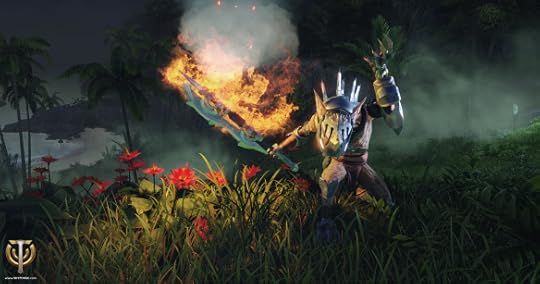 Skyforge definitely looks interesting, but I’m not quite ready to jump on the hype train yet.
Skyforge definitely looks interesting, but I’m not quite ready to jump on the hype train yet.
I will say, though, that I find it a bit surprising Skyforge isn’t getting more buzz. On paper, it seems very ambitious, and it’s doing a lot of unusual things that seem like they should be causing a stir.
Curious.
Filed under: Games Tagged: fantasy, sci-fi, Skyforge

November 27, 2014
Rage of the Old Gods, Chapter Seven: North
We have now come to the seventh chapter of Rage of the Old Gods, the first book of my epic science fantasy trilogy the World Spectrum. In the coming weeks, I will be posting the entire book for free on this blog. If you’re just joining us, you can get caught up with the previous chapters now.
 In this chapter, Yarnig presses into the frozen north and at last makes contact with the Northern Clans, a wild people separated from the rest of humanity since shortly after the Liberation. The Clanspeople are ancient enemies of Yarnig’s nation, but he finds they are not at all what he expected.
In this chapter, Yarnig presses into the frozen north and at last makes contact with the Northern Clans, a wild people separated from the rest of humanity since shortly after the Liberation. The Clanspeople are ancient enemies of Yarnig’s nation, but he finds they are not at all what he expected.
———————
Chapter seven: North
Snow. It seemed like the entire world was snow.
Yarnig and his people had been traversing the tundra for just over two days now, but it felt like they had been here forever. Yarnig could hardly remember what warmth was. Their universe had been reduced to wind, cold, and endless whiteness. White snow, white sky, white ice. White, white, white.
Erik held his staff forward, sensing the Clan magic and leading them slowly onward. The wizard believed they were getting closer, but he hadn’t been able to say how far away their goal was.
The wind did odd things with the snow, sculpting into abstract patterns, undulating waves, and endless hills and valleys. In places, much of it had been blown away, leaving the earth covered in but a thin sheet. In others, it had drifted so deep that the horses had to wade through it like a river. To Yarnig’s regret, they encountered more of the latter than the former.
Over time, he found that this land was not as lifeless as it seemed. Buried beneath the snow, he found various types of bushes, tall grass, and scrub. At night, they heard the eerie howls of wolves, and during the day, they would sometimes catch sight of vague shapes, herds, in the distance.
Harsh as it was, the land was alive.
The cold had begun to take its toll. The day before, one of the horses had died, and its rider now followed along on snowshoes. Taldin reported that frostbite had struck some of the men, and Yarnig felt himself become more exhausted by the minute. He had heard rumors that, when Leha had gone to Sy’om, she had nearly frozen to death. He was beginning to understand what that must have been like.
In his life in the royal court, Yarnig had learned to read people. Those beneath him, other than Erik and Taldin, didn’t generally speak to him, but he could see their fear in the way they carried themselves. He worried for them.
The previous night, the weather had taken a turn for the worse. The wind had picked up, and it had begun to snow. Based on what he had read of this land, Yarnig believed this to be a minor storm at best by the standards of the region, but there were southern regions of Tor Som that would have labeled it a blizzard. He had trouble seeing as far as the supply sleds they dragged behind them, and it was difficult to hear anything over the wind’s incessant roar.
He shivered in his cloak.
He thought he heard Erik say something. “What?” he shouted.
Erik pulled closer and shouted, “I think we’re getting close.”
The emperor grunted and looked ahead. Erik had been saying that all day. They continued forward, moving deeper into the colorless void.
Taldin held up a hand. “Does anyone else hear that?” he shouted.
The others drew to a halt. Yarnig tilted his head, listening.
“I don’t hear anything,” one of the soldiers said.
Yarnig leaned forward. He thought he could hear a low rumble. After a few moments, it grew louder. Something out there, separate from the wind, was producing a deep, steady noise. It reminded him of a fast-running river.
The sound increased in volume. Its soon drowned out the wind and horses’ tired huffing.
A dark shape appeared a few feet in front of Yarnig: a reindeer. Another appeared, and then another, and another.
A vast herd of reindeer, three abreast and at least ten deep, thundered past Yarnig’s company. Each was harnessed and connected to its neighbors. They pulled behind them what appeared to be a massive wooden sled as wide and tall as a large house and as long as one of the city blocks in Retgard. Windows had been spaced evenly along its length, and it had a thatched roof.
A platform sat at the front of the sled, and several fur-bundled people huddled there, controlling the reindeer or gazing out at the Tors. Dozens of long, faintly glowing silver spars extended from its sides, and Yarnig realized that it was not a sled at all. Its flat, boat-like bottom glided a few feet above the snow.
He wondered if he might be hallucinating.
As the massive structure floated past, he noticed that a number of small, one-man dogsleds had begun to circle his party, and he felt fear worm its way into his heart. He swallowed.
The rumble had become even more deafening. The emperor glanced behind them and saw that another of the mobile structures had arrived. Moments later, a third appeared. The three structures ground to a halt, and the noise died out. The hovering structures formed a triangle, and the Tors found themselves penned in.
Dozens of Clanspeople leapt from the structures and surrounded Yarnig’s party. Each carried an arm-length iron hook resembling a crowbar. The way the Clanspeople held them showed that they were weapons.
As they took their positions, they shouted amongst each other in their native language. Clanstongue and the Tor language were closely related, but Yarnig couldn’t pick out enough words to glean what they were saying.
Yarnig heard his men’s swords hiss out of their sheaths.
A handful of figures stood by just beyond the circle of Clan warriors. These held staffs capped with hollow hexagons of silver. Yarnig assumed these were battle wizards.
He felt the fear within him grow. The bitter history between the Clans and the Tors flashed through his mind, and he hoped that he hadn’t just led his party to their deaths.
“Tors, surrender your weapons,” a Clanswoman warrior shouted, speaking Tor roughly.
Yarnig and Taldin’s eyes met. Yarnig nodded slightly. Taldin frowned but offered no argument. He instructed his men to hand over their swords. Many of the soldiers grimaced, and Erik gave up his staff with great reluctance. Yarnig too felt a moment of trepidation as he handed over his sword. He had had not been trained in combat, but the cold metal had been reassuring.
A man with flowing golden hair emerged from the crowd. His body movements were strong and quick, but his face was weathered, and his hair was streaked with gray, so it was difficult to determine his exact age. He wore neither hat nor hood, and he held a longer, more ornate version of the weapons wielded by the men around him. The iron of his weapon had been polished to a dull sheen, and it was equipped with a spiked hand guard near the center of its shaft.
Yarnig took this to be their leader.
“Name yourselves!” the Clan leader shouted. His voice was strong and clear, and he had very little accent.
Yarnig cleared his throat and faced the Clansman. At the last moment, he threw back his hood. “I am Yarnig Tor Lannis, emperor of Tor Som. I have come to parlay with your people.” He hoped he sounded strong and confident.
The broad-shouldered Clansman didn’t seem to know how to react. He simply stared at Yarnig.
After a moment, Yarnig said, “May I inquire as to who you are?”
The Clan leader found his voice. “My name is Brodar. This is the village of the Marg clan. I am its chieftain.”
Yarnig’s court training kicked in. He made a half-bow – a signal of respect between equals. “It is an honor.”
Brodar grimaced. “What is your scheme, Tor? Our people have been at war from the time of our meeting. You will never be welcome here.”
Despite the cold, Yarnig began to sweat. “I come without guile. I speak truth when I say that I seek friendship with your people.”
A gust of wind whipped through the gaps in the hovering buildings, and snow stuck in Yarnig’s hair.
“I request to be allowed into your home so that we may discuss this in a more comfortable setting,” Yarnig said.
Brodar gestured with his weapon half-heartedly, seeming more annoyed than threatening. “Why should we discuss it at all? You have nothing to offer me. Leave now, Tor, and I will not harm you.” He turned and made his way back through the crowd.
“Wait!” Yarnig called. He searched for the right words. “Our people were not always enemies! Thousands of years ago, our ancestors fought together against the Old Gods. I seek to renew that alliance.”
Brodar paused. He turned around and walked back through the crowd, his feet crunching in the snow. “Is this truly what you seek? Do you give me your word?”
Yarnig bowed his head solemnly, hope blossoming in his chest. “I give you my word.”
Brodar hesitated, then nodded curtly. “Though I have no reason to trust the word of a Tor, I will give you a chance. Select two of your people. You may meet with me.” He began to walk away.
“What about the rest of my party?” Yarnig asked, shouting over the wind.
“We will give them shelter. They will not be harmed unless they give us cause,” Brodar answered over his shoulder.
Yarnig selected Erik and Taldin to accompany him. Taldin threw him a questioning look. Yarnig responded by nodding.
The three dismounted, submitted themselves to be searched, and were led into one of the massive floating buildings.
* * *
Yarnig hadn’t been sure what to expect from the Northern Clans, but it hadn’t been roads, and it hadn’t been anything like the Marg village.
Erik chattered in hushed tones about the floating halls. He wondered if the hovering effect was created by constant effort on the part of the Clan wizards or if they used some mechanism for channeling energy without human intervention. Yarnig hardly listened. He thought about the level of logistical efficiency a mobile village would require. It boggled the mind.
A Clansman led them into one of the halls and down a narrow passageway that ran the length of the structure. In here, the air was pleasantly warm, and everything was made of wood. Doors had been spaced evenly along the length of the hallway, but none were open. Yarnig caught hints of voices beyond some of them. The hollow sound his feet made on the floor planks led him to believe that an open space lay beneath. Magical, smokeless lanterns lit the hallway.
He had a thousand questions about how the village operated, but he decided it would be better to keep silent.
The hallway ended in a broad chamber near the back of the structure. The room held no furniture, but a number of tapestries, hunting trophies, and weapons adorned the walls. A pair of doors stood at either end of the far wall, and a large tapestry depicting a man flanked by reindeer hung between them. Yarnig thought the man resembled Brodar.
Near the center of the room, between two columns, Brodar sat upon a cushion upholstered with reindeer hide. Just behind and to either side of him, an elderly man and woman sat upon identical cushions. Three more of the cushions had been arranged in a similar pattern before the chieftain.
The Clan guide departed, his footsteps echoing up the corridor, and Yarnig’s group came forward to sit on the cushions. Yarnig took the center one, finding it surprisingly comfortable. He loosened his cloak. It felt good to be out of the wind.
“Welcome to my home,” the chieftain said, though there was nothing welcoming in his tone.
Yarnig took a deep breath and met Brodar’s steely stare. “Allow me to introduce my companions. This is Taldin, the captain of my guard, and Erik, my battle wizard.”
Taldin bowed, and Erik followed suit.
Brodar gestured to the man beside him. “This is my father, Tergor.” The old man bowed his white-haired head. He looked as if he had once been a man as imposing as his son. “And this is my mother, Eskwel,” he said, gesturing to his left. Eskwel was stocky, and her iron gray hair was bound in two braids.
“Your parents?” Erik said.
Yarnig fixed him with a disapproving glare.
“Who better to advise me?” Brodar said.
“I apologize for my man, chieftain,” Yarnig said. “He meant no disrespect.”
Brodar shrugged it off.
A servant appeared, bearing a tray with six ceramic cups upon it. The servant passed out the cups to the two leaders and their companions and departed without a word.
Yarnig held up his cup. It felt warm and contained a thick, off-white liquid. “What is this?” he asked politely.
“Ulu. The milk and blood of reindeer, mixed with honey,” Brodar said. He took a deep draft from his cup.
Yarnig took a hesitant sip, and his men did the same a moment later. The ulu tasted sweet, and it helped to chase away the cold he had suffered through for the past few days. He didn’t think that Brodar would try to poison him. Everything he had read about the Northern Clans led him to believe that, if the chieftain wanted to kill him, he would simply gut him with one of those metal hooks.
After he swallowed, he remembered how wrong his books had been about so many other aspects of the Clans.
Brodar put aside his drink. “Allow me to be clear, Tor. I allow you here because I am curious. I treat you with respect and hospitality because I pride myself on being an honorable and decent man. If you give me reason to, I will immediately end my display of kindness. If you attempt to harm me or any of my people, none of your group will leave this place alive.”
Yarnig swallowed. “Understood.”
“Now, tell me why you have come here, Leader of Tors.”
Yarnig resisted the urge to clear his throat again, remembering how his father had admonished him for that habit. “In the lands south of here, the Automatons have risen up against their masters. They seek – ”
Brodar held up a hand. “I am aware of this. My people are isolated, but we are not completely cut off from the outside world.”
Yarnig maintained his composure by sheer strength of will. Pushing down his embarrassment, he searched for the right thing to say.
He took a deep breath. “Do you also know that they are the Old Gods reborn?”
Brodar’s eyebrows raised. “What?”
His parents’ eyes widened, and Tergor whispered a quick stream of words in his ear. Apparently, his parents understood Yarnig’s language.
“It is difficult to believe, I know,” Yarnig said, trying to keep his pulse slow. “I didn’t believe it myself at first. Allow me to explain.”
“Please, do,” Brodar said icily.
Yarnig hoped the chieftain’s doubt would not be their downfall. He took a gulp of ulu. The sweet brew helped to calm him, and if it was poisoned, he was probably already doomed. “In the south, our armies are led by an Eastenholder woman. Her name is Leha. Six months ago, she discovered a weakness in the Old Gods’ seal, and she traveled to the other worlds. Her adventures were too many for me to describe quickly, but what is important is that, when she went to Tyzu, she was forced to do battle with an Old God. It had been trapped on that world when the seal was put in place. When she reached its lair, she discovered that it was an Automaton.”
Yarnig couldn’t read Brodar’s expression. He continued. “We cannot say for sure, but we believe that Wizard Vorren, rather than inventing the Automatons, discovered the decayed wreck of an Old God and, not knowing what it was, reverse-engineered it, then claimed it as his own creation. It is believed that the machines have been biding their time for thousands of years, waiting for the moment when they would be strong enough to overthrow us and return to power.”
The chieftain seemed to still be listening.
Yarnig pressed on. “My own nation is partly to blame for this. The Tor Vargis, another royal family, ordered the creation of a new model of Automaton. These could wield magic as well as any battle wizard – better, in fact. They then used the new machines to invade Eastenhold. The devastation of their war, and the new powers they granted the Automatons, were most likely the cause of the machines’ revolt. It is perhaps the darkest chapter in my people’s history.”
Brodar sat in silence, working his jaw back and forth. His parents whispered into his ears.
“I do not know whether I believe you or not. History tells me not to trust you, but, as my mother pointed out, if you wanted to deceive me, you would have created a far more believable lie.”
Yarnig sipped his ulu. It left a faint metallic aftertaste. “I assure you, I speak the truth.”
“He does, chieftain,” Erik added.
Yarnig shot his friend another glare. Taldin rolled his eyes.
A strong blast of wind rattled the windows.
“There is something I don’t understand,” Brodar said.
“Yes?” Yarnig said, putting on a mask of helpfulness.
Brodar placed his elbows on his knees and leaned forward. “You said that your armies are led by an Eastenholder woman. I know of the history between your two nations. It is nearly as bloody as the conflicts between our peoples. Why would you entrust your safety to her?”
“Leha is a remarkable woman. The Automatons rose up while our army attacked Heart, the Eastenholder capitol. The Battle of Heart became one of the most devastating conflicts since the Liberation.
“Leha came into that chaos from Tyzu, having been greatly changed by the people there, the Lost Ones. She took charge of the defense and united the warring armies of Tor Som and Eastenhold. In less than a day, she brought humanity to victory.
“Afterward, she went north, to Tor Som, and gathered together all she encountered into a great host. It is not the forces of Tor Som, but the forces of humanity that she commands. Even the armies of Sy’om and Tyzu flock to her call to arms.”
This wasn’t entirely true. Many had refused to join her army. Some of the people she had encountered on her journey had chosen to stay where they were; others had chosen flight over fighting. Many Tors had been unable to accept the leadership of an Eastenholder and fled into the wilderness.
Brodar frowned in thought. “What you say is almost beyond belief, but if this is an attempt at deception, it is a poor one. And the fact that you risked yourself by coming here speaks to your sincerity.”
He shook his head. “I do not wish to believe you, Tor. But I cannot see the gain in trying to trick my people when your own face extinction. And some among the Clans have already wondered what the machines will do once they have wiped you southerners from existence. Some say we should face the problem proactively…”
Yarnig leaned forward hopefully.
“I must consult with my people,” Brodar said. He said something to Eskwel in Clanstongue, and she produced two thin metal rods from a pocket. She struck them together, producing a high, clear note. Yarnig heard footsteps in the hall behind them.
“You will wait outside.”
Yarnig worried that Brodar meant outside the hall, but instead, he, Erik, and Taldin were brought to a small room elsewhere in the hall. They waited there for almost an hour, Erik chattering nervously, before Brodar called them back.
Yarnig had the impression others had joined Brodar’s council, but by the time his group returned, it was just Brodar, Eskwel, and Tergor again.
“If I agree to help you, what would you have me do?” Brodar said when Yarnig’s group had taken their seats.
Yarnig reassembled his calm mask. “During the Liberation, all of humanity fought together. If we are to defeat the machines again, we must do so as a race united.” He straightened. “I would have you commit as many fighting bodies and as much of your resources as you can spare to the war effort. I would have you aid me in convincing your entire nation to help fight the Automaton threat.”
Brodar said nothing. His face showed that he was considering what Yarnig had said. The only sound was the howling wind outside.
“Do you know that, if you want to enlist the help of all the Clans, your request will have to be approved by the Althing?” the chieftain said, breaking his silence.
“The Althing?” Yarnig said.
“The annual meeting of the Clans. The chieftains meet then to vote on issues that affect our nation as a whole.”
“When is the next Althing?” Yarnig asked.
“The Althing is traditionally held midway between the spring equinox and the summer solstice. But because this is a matter of such grave importance, I can call an emergency one much sooner. It would still take at least a month for the Clans to assemble.”
Yarnig’s heart fell. “What about you? Can we count on the aid of the Marg clan?”
Brodar set his jaw. “I have not reached a decision. I must think. One of my people will show you to where your companions are staying. You will be given food and shelter until I reach my decision,” Brodar said.
Eskwel again struck the metal rods together again, and Yarnig heard servants approach.
Yarnig stood, trying to hope for the best. At the very least, it didn’t look as if the Clanspeople would try to harm him or his group.
That was a good sign.
* * *
While the machines built new warriors and upgraded themselves into ever more deadly forms, the people in Marlhem made their own preparations for battle.
All across the city, day in and day out, smiths and craftspeople churned out weapons, their fires smoking and their hammers ringing against their anvils. Requests were sent to other cities for the wood to make crossbows and spear shafts. Armor was produced from metal, leather, and whatever else was available. The neighboring cities of Kerhem and Yotgard shipped in whatever reinforcements they could, but there was always the chance that the Automatons would attack them instead of Marlhem, and Leha and the other leaders didn’t want to risk putting all their eggs in one basket.
The remains of destroyed Automatons were stripped down for their metals, and the ruins of the city were scavenged for whatever could be found within them. Leha and her people had fought many victories over the Automatons, but none had been easy, and all had been costly. A simple lack of resources threatened them nearly as much as the Automatons did.
The more experienced soldiers combed the city for new recruits, arming and training whomever they could find. Each morning, Leha heard their shouts and marching songs drift from the drilling fields.
When the Lost One clans had sent their armies to Barria, they had also dispatched a number of wizards. Lost One wizards had never been trained to use silver, but their Barrian counterparts had equipped them with staffs and wands, and they worked continuously to master new spells and abilities.
The entire city thrummed with activity. Everyone had a role to play. Leha sometimes wondered how things could be so organized. Back in Three Gates, she had only had to run her own shop, and she had been merely competent, at best, at that. Just the thought of the responsibility of readying an entire city to defend against an army of Automatons made her mind reel.
The odd thing was, though she was the one in charge of things, she had very little to do in the work of preparing. She worked on the broader plans, but Eranna, Natoma, and the others handled all the details. It seemed unfair that she received all the credit for work done by other people. It made her wonder if the heroes in her histories deserved all of the credit they received.
Every day and night, the threat of attack hung over the city. The machines could arrive at any moment, and the knowledge of this brooded in the back of everyone’s minds. While they weren’t known for agility, Automatons could move very fast in a straight line, and once the scouts spotted them, there would be only minutes to prepare.
A few days after the arrival of the Urannans, an abandoned building had collapsed. Hearing the echoes of its crumbling, a number of people had thought the Automatons were attacking, and they’d caused a panic. Men, women, and children had run through the streets, screaming. Some had tried to flee the city. Two-dozen new recruits had lost their nerve and tried to desert. The chaos had continued for half an hour before Leha, with Natoma’s help, became organized enough to get Benefactor’s people to broadcast the knowledge that there was no cause for concern.
Not a good sign.
Their tactical situation was no cause for joy, either. The walls of the city had been punctured at numerous points, and nothing they could plug them with would provide any resistance to an Automaton. The intact portions of wall would barely slow them.
Leha had gathered well over twenty thousand fighters from Heart, South Tower, Karkar, Tor Som, and Tyzu over the past six months, but many of those had been wounded or killed in the journey north and in various battles with the Automatons, and many others had been sent to reinforce the neighboring cities or perform other tasks, so the number available to defend Marlhem was closer to ten thousand. On top of that, the majority of them were suffering from fatigue or low morale, and others were green troops with little training and less experience.
They were miles away from the nearest occupied settlement, and the plains offered no hiding places. If the machines breached the defenses, it would quickly become a slaughter in the streets. There was nowhere for people to run. Leha would have liked to evacuate the majority of the civilians to Tyzu or one of the neighboring cities, but most people didn’t want to abandon their homes.
Drogin continued his work on new weapons to use against the machines, but even if they worked, it would take a long time to produce large quantities of them, and Leha didn’t think they’d make the difference.
As always, it all came down to Leha and her abilities. She could command powers that no one else could, and that the machines could not adapt to. It was all on her, a shopkeeper from Three Gates with no military training beyond an armload of history books and adventure novels.
However, this time, they did have one other advantage: Natoma. In the two weeks since her arrival, she had proven herself to be a capable leader with an impressive understanding of tactics, logistics, and command. Up until now, their main sources of military knowledge had been Eranna, who had little command experience; Doga, who was accustomed to fighting nothing better organized than marauding bands of Stassai; and Yeldar, who was unused to working on a large scale. It hadn’t taken long for the Urannan captain to improve everything from their food rationing to their command structure.
She also proved to be a good influence on the cadets. Her calm, confident demeanor helped to put them at ease, and she had the leadership experience to drill them into shape.
People all across the city came to defer to her leadership, and she became nearly as prominent a figure as Leha.
Leha, too, found herself admiring Natoma. Unlike herself, she knew how to lead and how to cope with situations like the one they now faced.
Every day, Natoma would go down to the old market square – a place that had been built upon a jumping point to Tyzu and was now used as Marlhem’s link to that world – choose an out of the way spot, and spend a half-hour practicing a series of exercises to improve her swordsmanship. She would stand among the crates of fruit and the comings and goings of Lost Ones, her armor gleaming dully in the shadows of the buildings around her, her single-edged sword shining like light incarnate as it caught the sun, and glide through the forms and postures.
Sometimes, she would attract an audience. The Lost Ones in particular seemed impressed with her skill. Whenever she had the chance, Leha would come to observe. Natoma moved with a natural grace and agility that seemed almost superhuman. She could be as slow and languid as a cat one moment, and then flash into a blindingly quick strike the next. Every little twitch seemed planned and coordinated. If her hair became disheveled while she exercised, it somehow seemed intentional and artistic. Even her sweat seemed carefully coordinated to bead and shine so that it would enhance her image of elegant strength. And it all seemed to be effortless.
Leha could move like that too, easily. But her abilities had come from the mutations the Lost Ones had given her. She had willed her muscles into a state of near perfection over just a few days, and she had done so with little effort. Natoma’s grace came from hard work and years of training. She had earned it.
Natoma didn’t talk about her time in Uranna much, and when she did, she mostly spoke about her early years there. On the rare occasions when she discussed the nation’s fall, Leha again got the impression that this was a pain from years ago, a pain that Natoma had managed to put behind her. The grief in her eyes seemed distant somehow.
Natoma’s Eastenholder improved rabidly, and the need for Lahune’s translation evaporated. She still couldn’t speak the Tor language, but most people in the city had learned fluent Eastenholder by having the understanding fed into their minds by Benefactor’s people, and she was able to get by.
Once he stopped acting as translator, Leha saw little of Lahune. Drogin had told her of his vocation as priest – his knowledge of languages apparently stemmed from his order’s belief that spoken language, as something uniquely human, was something to be celebrated. She’d never been able to decide what she thought about the cult of Aya, but he seemed harmless, so she decided not to worry. Sometimes, she saw him conversing with Doga. The Urannan and the Lost One seemed to have discovered some common ground.
Sixteen days after the arrival of the Urannans, Natoma and Leha leaned against a building in the market square. It had been a quiet morning, and Leha had stayed after watching Natoma’s exercises.
They stood in the shade created by a three-story building and a stack of crates. People buzzed through the square near them, but none of them noticed the two women. Nearby, a flock of pigeons murmured to each other. The morning was cool, but the sun helped to warm the air.
They discussed the Automatons, going over various scenarios for the impending attack and the defense of the city. They had said it all before, but they said it again. Going over the practicalities helped Leha to forget the odds they faced.
Eventually, they ran out of things to repeat, and the conversation died off.
Leha gazed into the bright sky and tried to work up the energy to return to work.
“May I ask you something?” Natoma said. Her voice still carried an accent.
Leha turned her head to face her. “Go ahead.”
Natoma searched for the words. “I don’t understand why you are the only person who can channel the powers of the other worlds. What I mean is: why haven’t more people been given your abilities? My understanding of the memories you showed me is that you and the Lost Ones are all capable of transforming others the way you were transformed. It seems that it would be much easier for you, and everyone else, if there were many with your abilities.”
Leha became acutely aware of the claws on her feet digging into the snow, of the inch long spikes extending from her fingers, and of her deep blue pupils. She broke into a sweat despite the cold, but there was nothing of accusation in Natoma’s serene, porcelain-skinned face. Leha took a breath and decided to be honest.
“What I tell Drogin is that it’s too risky to the subjects. And that’s true; the ability to control our bodies, and the chemicals they produce, is very much an intuitive thing. There’s no guarantee anyone would be able to exactly replicate the toxin that transformed me. And there are any number of factors that could have played in a role in what happened to me. We don’t know.”
She stared at the ground. “But there’s more. These new abilities have given me a great deal of power. You’re a skilled fighter, but I could spill your blood on the stones before your sword grazed my cloak. I’ve fought Wizard-Automatons and lived. I don’t know if I trust anyone else with that kind of power. I’m not sure I trust myself with that kind of power, but it’s too late for that. What if I created another like me, and they betrayed us and sided with the Automatons? What would brawls, and fights, and wars be like if people’s very bodies are weapons?”
She shook her head. “There’s too much uncertainty.”
People fluttered through the square.
“I understand,” Natoma said.
Leha looked at her, and smiled.
———————
Enjoying the story so far? The next chapter will be posted soon, but if you can’t wait, you also have the opportunity buy the full ebook now!
Filed under: My writing, World Spectrum Tagged: books, fantasy, Rage of the Old Gods free chapters, sci-fi, steampunk, The World Spectrum, writing

November 24, 2014
Warlords of Draenor: On the Outside Looking In
I find myself in an interesting position just now. For the first time since I started playing, I am missing out on the launch of a new World of Warcraft expansion, having cancelled my subscription shortly before the release of Warlords of Draenor. I don’t intend this to be a permanent departure; I just didn’t feel right paying 25% more for an expansion that seems to remove as much as it adds. I’ll be back once the price drops and/or Blizzard shifts their designs back to something more palatable.
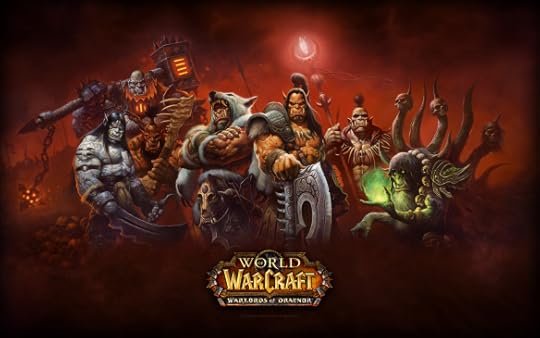 But like a heartsick man lurking on his ex’s Facebook page, I am maintaining a close eye on the Warcraft community to see how WoD is being received. It is somewhat interesting to be seeing the expansion entirely through the eyes of others.
But like a heartsick man lurking on his ex’s Facebook page, I am maintaining a close eye on the Warcraft community to see how WoD is being received. It is somewhat interesting to be seeing the expansion entirely through the eyes of others.
It is of course difficult to get an accurate picture this way. There is the temptation to declare the reception of WoD to be overwhelmingly negative, but it is important to remember that discussions online always have a negative bent, because those who are happy are busy playing rather than posting on forums.
I also have a certain bias, because I go into this expansion with a very low opinion of it. I am not happy with the decisions Blizzard has made in regards to Warlords of Draenor, either in terms of lore or gameplay. So naturally I’m biased to seek out opinions that align with my own, negative, view.
With those caveats out of the way, I now present to you my views on WoD so far, based entirely on secondhand reports.
Launch and the population spike:
It’s hard to say whether the launch of WoD is more good news or bad news for Blizzard. On the one hand, it was a trainwreck of epic proportions, by all reports. On the other hand, part of that is because so many people have returned to the game for the launch. Last reports have WoW back at ten million subscribers, numbers not seen since the launch of Mists of Pandaria.
 Both haters and fans are eager to use these events to justify their personal narratives, but for my part, I think both are over-blowing things.
Both haters and fans are eager to use these events to justify their personal narratives, but for my part, I think both are over-blowing things.
I do think it’s embarrassing that a company as successful and as experienced as Blizzard is still having problems like this. They can and should do better.
With that said, though, launches are always going to be somewhat ugly, and it’s all fairly irrelevant in the greater scheme of things. The quality of the expansion is far more important than the quality of its launch.
Conversely, I also think the surge in population is largely meaningless in the greater scheme of things. A WoW expansion always triggers a large surge of population, but if history is any guide, those gains will be very short-lived. Mists also saw a big jump in population at launch, but it didn’t take long for those numbers to crash and crash hard.
World of Warcraft is a game a lot of people have a lot of nostalgia for, and when a new expansion launches, it gets people curious to check out the old flame. Most will then leave once again when they realize WoW is still WoW. It’s unlikely Blizzard will ever overhaul the game enough to win back a significant quantity of those who have decided WoW is no longer for them, and I certainly don’t think Warlords of Draenor is the expansion to do that.
Flying:
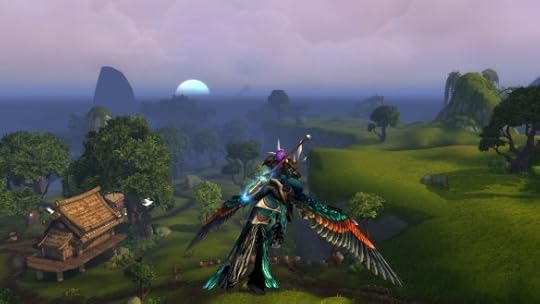 Perhaps not surprisingly, the inability to use flying mounts on Draenor remains the expansion’s greatest controversy. It’s been over a year since the announcement was made, and discussions of it are still cropping up constantly.
Perhaps not surprisingly, the inability to use flying mounts on Draenor remains the expansion’s greatest controversy. It’s been over a year since the announcement was made, and discussions of it are still cropping up constantly.
And opinions on the matter seem surprisingly uniform. Every post in favour of restoring flight — and there are a lot of them — is inundated with “likes” and posts of support, and every post in favour of the status quo is buried with downvotes and dissenting opinions.
This is probably as close to unanimous opinion as I have ever seen in the Warcraft community. Even Pandaria’s dailies — which are now widely acknowledged to have been a mistake — had much more and more vocal fans than a world without flying does.
This comes as no surprise. Many people, myself included, have argued that turning off flight after making it a mainstay of the game for the majority of its lifespan will do no good at all. It’s only common sense.
Yet Blizzard ignored all feedback on the matter, just as they did when those of us in the Mists beta overwhelmingly argued against the daily grind. “You’ll like it once you try it,” they said, blithely ignoring the fact that we have all tried it every time we level a new alt. Now people are living it live, and despite Blizzard’s words to the contrary, opinions have not changed.
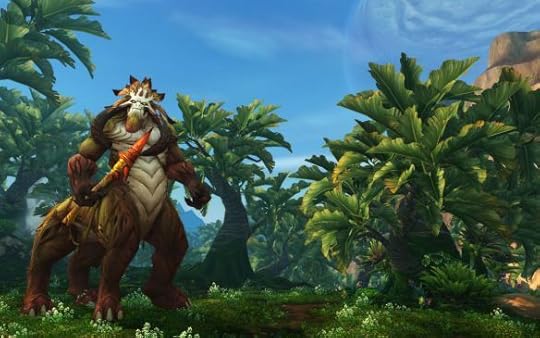 I maintain what I have said from the beginning: This will come to be remembered as the greatest blunder of Warlords of Draenor. Flying will return, and this experiment will not be repeated again, though they might come up with another equally whacky way to try to fix something that was never broken.
I maintain what I have said from the beginning: This will come to be remembered as the greatest blunder of Warlords of Draenor. Flying will return, and this experiment will not be repeated again, though they might come up with another equally whacky way to try to fix something that was never broken.
Size does matter:
Something else which is a matter of some controversy is whether there’s enough to do in WoD. Certainly as an outsider it appears to me to be far smaller and less ambitious than previous expansions, and I have seen many people complain they’re already running out of things to do.
It’s hard to say whether these criticisms are valid are not, because bored WoW players are like depressed teenagers. That’s kind of their nature. If you’re on a WoW forum and no one says they’ve run out of things to do, you’re not on a WoW forum.
However, there are some elements of these discussions I find telling.
What makes me think there might be something to the idea that WoD is a lacking expansion is not the arguments made for that notion, but those against it. I’ve seen people rattle off very long lists of the innumerable activities there are in Warlords of Draenor… but at least half the things mentioned tend to be things you see in every expansion (gee, raids, that’s new and exciting), some even count the content of previous expansions, and often garrisons get counted multiple times in such lists.
You can level your buildings, and you can level followers, but those are both just parts of managing your garrison. Listing those as separate activities seems to me a bit like listing killing trash and killing bosses as separate things, when they’re both just parts of running dungeons. It certainly doesn’t counter the prevailing perception that WoD has little to offer beyond garrisons.
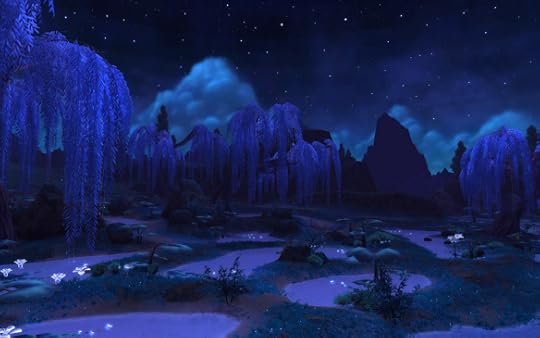 The extent to which facts need to be twisted to show WoD as having a bounty of content does not inspire confidence.
The extent to which facts need to be twisted to show WoD as having a bounty of content does not inspire confidence.
The anniversary:
The one thing I regretted about choosing to be a late adopter for WoD was missing out on the tenth anniversary celebration. Having read reactions to it, that regret has faded.
The Raid Finder revamp of Molten Core has not been well-received. It has been plagued by game-breaking bugs, and is reported to be extremely over-tuned, to the point where groups are wiping on trash and taking hours to complete it. To add insult to injury, only the final boss drops loot of any kind, making it a long slog for little reward.
Now, the anniversary version of the raid is going to be around for several weeks, and as people gear up, it will get vastly easier. It’s still very early in the expansion, and no one’s geared yet.
But I wonder why that has to be an issue. This is an anniversary celebration; it’s supposed to be a present to the players. Why does it need to present any challenge at all?
Once again, I feel The Secret World has the right idea. That’s a game that’s not at all afraid to challenge its players, sometimes brutally, but when it comes to event bosses, they make them straight up loot pinatas where failure is downright impossible. It’s a nice way to reward players, and give them a break from the more difficult content.
Even calling these “conclusions” is probably a little disingenuous, since I won’t be able to form any really strong opinions of the expansion until I play it. I’m not sure if all the negativity I’m seeing is indicative of an overall failed expansion, or just a combination of the usual cantankerousness of the gaming community mixed with my own bias.
And to be fair, I’ve seen plenty of people expressing a lot of love for this expansion, but at the same time, a lot of them seem the type to just love anything Blizzard puts out because they’re that into WoW. That is not at all a criticism of them; indeed, I envy their ability to simply enjoy the game.
But let’s put it this way: I’ve yet to see anyone articulate a reason for why WoD is better than anything that came before it.
One thing does seem clear to me: Warlords of Draenor is not setting the world on fire. While I’m not sure it has been worse received than past expansions, it certainly doesn’t seem to be any better received. Going in, many seemed to think WoD would herald a renaissance for WoW, and I really don’t think that’s going to be the case.
The only evidence to back such an idea is the surge in population, but that will only mean something if those gains can be maintained for more than a few months.
 For the most part, it seems as though WoD is just another WoW expansion, with little to distinguish it from its forebears. Whether that’s a compliment or a criticism depends on personal perspective, but I don’t think it’s going to do much in the long to halt WoW’s slow decline, and I think those expecting the second coming of MMO Jesus are destined for disappointment.
For the most part, it seems as though WoD is just another WoW expansion, with little to distinguish it from its forebears. Whether that’s a compliment or a criticism depends on personal perspective, but I don’t think it’s going to do much in the long to halt WoW’s slow decline, and I think those expecting the second coming of MMO Jesus are destined for disappointment.
Filed under: Games Tagged: epic nerd rant, fantasy, Warcraft, World of Warcraft

November 21, 2014
Review: Van Helsing 2: Ink Hunt DLC
At this point, I think it’s safe to say that I’m a fairly big fan of the Incredible Adventures of Van Helsing games. I’m not sure I’d nominate them for game of the year, but for bargain priced indie games, they offer an incredibly polished and fun experience.
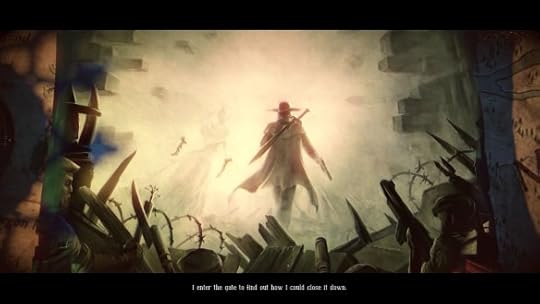 Therefore I was glad to see Van Helsing 2 get a fairly meaty DLC in the form of Ink Hunt, which features a new storyline spanning multiple quests. I picked it up on a Steam sale a few months ago, and with a gap in my gaming schedule opening up due to the end of Halloween in The Secret World and my World of Warcraft subscription expiring, I finally got around to playing through it yesterday.
Therefore I was glad to see Van Helsing 2 get a fairly meaty DLC in the form of Ink Hunt, which features a new storyline spanning multiple quests. I picked it up on a Steam sale a few months ago, and with a gap in my gaming schedule opening up due to the end of Halloween in The Secret World and my World of Warcraft subscription expiring, I finally got around to playing through it yesterday.
Ink Hunt takes place shortly after the events of The Incredible Adventures of Van Helsing II and features an Ink gate opening dangerously close to Van Helsing’s Secret Lair. With the heart of the Borgovian resistance threatened, Van Helsing and the Lady Katarina venture into the Ink to discover the source of the disruption and stop it. Not surprisingly, it doesn’t take long for evidence of Prisoner Seven’s involvement to appear.
For the most part, it’s the experience I’ve come to expect from the Van Helsing games. A light-hearted romp with plenty of action and humour.
I was a bit worried that Ink Hunt might feel a little half-assed — that it would be just a shameless attempt to wring more money out of the consumer — but for the most part it displays the same charm and high quality of the main game.
Once again, there’s no shortage of jokes, Easter eggs, and secrets. My favourite by far was a pair of domovoy reenacting the famous scene from Titanic.
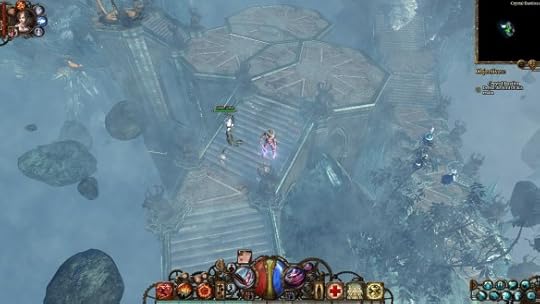 Ink Hunt also features quite a bit of new environment art, some of which is quite spectacular, and a number of new monster types. It’s not at all just a recycling of assets from the main game.
Ink Hunt also features quite a bit of new environment art, some of which is quite spectacular, and a number of new monster types. It’s not at all just a recycling of assets from the main game.
It does lack a few features of the main game — mainly the tower defense and resistance command mini-games — but given the content of Ink Hunt, I think that’s understandable. I suppose a tower defense map might have been nice, though.
On the plus side, the player still has access to Fluffy the Chimera and can continue to send him on missions in the Ink and/or summon him for assistance in combat.
That said, Ink Hunt does have some issues. Most notably, the difficulty seems extremely high. I’m guessing it was tuned around the assumption the player had been running a lot of scenarios and had spent a lot of time perfecting their gear, but as someone who only finished the main storyline and then moved on, I got manhandled pretty badly.
But once I turned down the difficulty setting, I did fine, so that’s not too big an issue.
 Ink Hunt is also very short. I completed it all in just under two hours. But it is only a DLC, so I can’t complain too much.
Ink Hunt is also very short. I completed it all in just under two hours. But it is only a DLC, so I can’t complain too much.
Overall rating: 7.2/10
Filed under: Games, Reviews Tagged: downloadable content, fantasy, review, The Incredible Adventures of Van Helsing








November 18, 2014
Pointless Nostalgia: Gaming
We now continue with my series of self-indulgent nostalgia posts discussing the sci-fi and fantasy I loved as a child, which turned me into the proud nerd I am today.
 This time, I’ll be discussing video games. Note that I am limiting this to sci-fi or fantasy games that had a significant impact on my views of those genres, so there are some games that I truly loved that will not be discussed in this post. The Age of Empires franchise, for instance.
This time, I’ll be discussing video games. Note that I am limiting this to sci-fi or fantasy games that had a significant impact on my views of those genres, so there are some games that I truly loved that will not be discussed in this post. The Age of Empires franchise, for instance.
Some of these are also games that I’ve discussed before, so my thoughts on them may be a little truncated to avoid repeating myself too much.
Warcraft:
Of course, Warcraft is always the first game franchise that comes to mind on this topic. Warcraft: Orcs and Humans wasn’t the first game I ever played, but I did start on it very early in my life, and it’s probably the first one to have had a major impact on my tastes going forward. I would go on to spend an enormous amount of time playing it and its sequel, Warcraft II: Tides of Darkness.
In retrospect, the early Warcraft games weren’t particularly special by modern standards. They were fantastic given the limitations of the era, but looked at through modern eyes, they were fairly thin experiences that shamelessly ripped off Warhammer and Lord of the Rings.
Still, I loved them at the time, and Warcraft II is noteworthy for kickstarting my lifelong love affair with Elves. With their coolly confident voices, lethal ranged attacks, badass capes, and epic hair, my seven year-old self thought the Elven archer units were just the most amazing thing ever.
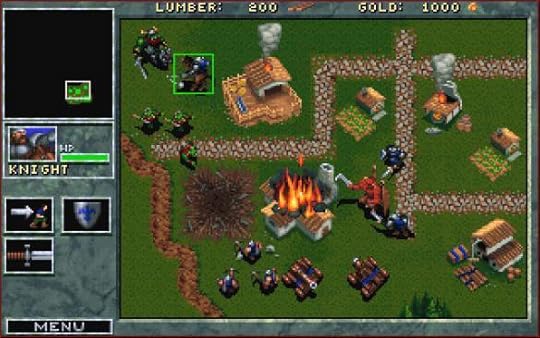 Warcraft III, however, was something special. It vastly expanded the universe and added an incredibly amount of depth and complexity to what was previously a very simple story.
Warcraft III, however, was something special. It vastly expanded the universe and added an incredibly amount of depth and complexity to what was previously a very simple story.
Timing also played a role in my love for Warcraft III. It came around just as I was getting old enough to understand that the world isn’t entirely black and white. I think it had a profound impact on my sensibilities as a writer, and as a person. It helped to waken me to the idea that there is more than one perspective on everything, that one person’s villain is another’s hero.
The expansion, The Frozen Throne, was less impressive, but it did take my Elf obsession to new heights by reinventing the Elves as the Blood Elves, who remain my favourite interpretation of the archetype from any source.
Again, timing plays a role. To my teenage brain, the edgy, sexy, misunderstood Blood Elves seemed irresistibly cool.
StarCraft:
Blizzard’s other great RTS franchise also deserves a mention, but truthfully, I’m not sure it really had that big an impact on me.
 Now, don’t get me wrong. I loved StarCraft, and still do. It was a great game with a strong if somewhat imperfect story, and from a gameplay perspective, it was a quantum leap forward for the genre.
Now, don’t get me wrong. I loved StarCraft, and still do. It was a great game with a strong if somewhat imperfect story, and from a gameplay perspective, it was a quantum leap forward for the genre.
I’m just having trouble drawing any direct lines between my love of StarCraft and my current sensibilities. I had already developed a certain degree of interest in sci-fi thanks to things like Star Trek and Beast Wars.
Mostly all I can say is that Jim Raynor was and remains my all-time favourite video game character, a rare example of a character who is presented as an everyman forced into the role of hero and actually feels authentic as both.
One nice thing is that StarCraft 1 is the only entry on this list that can be readily played today, without dealing with technical issues or outdated graphics and game mechanics.
Drakan: Order of the Flame
Here’s a game that’s definitely not remembered as one of the great classics. Still, it was special in its way, and I remember enjoying it a lot — despite some glaring problems.
 Drakan was a fairly generic fantasy story — Evil McBadPerson is coming back from the dead to destroy the world, unlikely hero must stop him — centered on a young woman named Rynn, who bore a remarkable resemblance to Lara Croft. Rynn stumbles across a dragon named Arokh and winds up soul-bound with him.
Drakan was a fairly generic fantasy story — Evil McBadPerson is coming back from the dead to destroy the world, unlikely hero must stop him — centered on a young woman named Rynn, who bore a remarkable resemblance to Lara Croft. Rynn stumbles across a dragon named Arokh and winds up soul-bound with him.
So the gameplay split between content played as Rynn and aerial sequences atop Arokh.
Arokh is what made the game worth playing. His wry humour and cynicism gave him infinitely more personality than Rynn, but the gameplay of playing as a dragon-rider is what made Drakan really special.
Few things in my gaming career have equaled the sheer thrill of soaring through the air atop a fire-breathing dragon, and Drakan made it every bit as amazing as you would expect. The controls were simple and intuitive, the maps were expansive and full of potential for exploration, and Arokh’s power was awesome in the truest sense of the term. Enemies that would be challenging or nearly unbeatable as Rynn could be effortlessly incinerated by Arokh.
Despite its generic story, Drakan impressed upon me the sense of awe and wonder that the fantasy genre is capable of, and I still have many fond memories of soaring across the Eastern Archipelago, raining fire on my enemies.
 Drakan is also noteworthy for beginning my lifelong hatred of jumping puzzles and platforming mechanics. I truly believe the gaming industry has evolved beyond the need for such things; I wish they’d just go away altogether.
Drakan is also noteworthy for beginning my lifelong hatred of jumping puzzles and platforming mechanics. I truly believe the gaming industry has evolved beyond the need for such things; I wish they’d just go away altogether.
Myth:
I am not given to looking back with rose-coloured glasses. I am not someone who grumpily declares that games were so much better back in the day and the current crop of games just can’t compare.
But the Myth franchise was something so unique and special that even today I’ve never quite seen a game equal it.
For whatever reason, Myth: The Fallen Lords and Myth II: Soulblighter* did not become elevated to the pantheon of all-time great RTS games like Age of Empires and StarCraft, but they deserved to be. They ought not to languish in forgotten obscurity as they do.
*(We don’t talk about Myth III. It didn’t happen.)
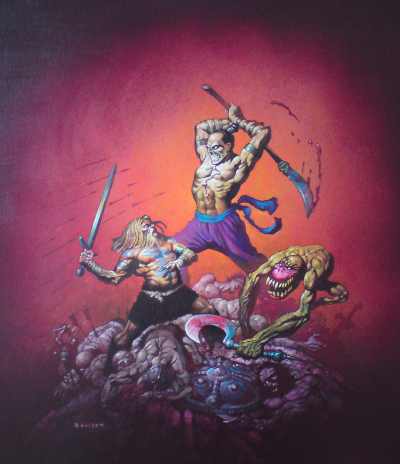 Myth wasn’t like other strategy games. There was no base-building, no economy. Only very rarely would you ever receive reinforcements during a mission, and you virtually never had any control over when you got them. It was just you and a small group of soldiers fighting against impossible odds.
Myth wasn’t like other strategy games. There was no base-building, no economy. Only very rarely would you ever receive reinforcements during a mission, and you virtually never had any control over when you got them. It was just you and a small group of soldiers fighting against impossible odds.
And things did often feel all but impossible. These were brutally difficult games, which is my one complaint about them. You were invariably outnumbered, often outgunned, and there were a million little things that could go wrong.
Which brings me to another unique thing about Myth, which was how incredibly realistic the combat was. It’s hard to imagine, but these janky old games from the 90s managed a level of realism that is unheard of even today. Wind could blow your archers’ arrows off course. Rain could cause your Dwarves’ grenades to fizzle out. Body parts rolled downhill. Explosions sent deadly chunks of shrapnel wheeling across the battlefield, cutting apart friend and foe alike.
This immense realism and the complexity it created were a big contributor to Myth’s difficulty. One wrong move could send a grenade flying into your own Dwarves, causing a chain reaction as the grenade set off their satchel charges. This would turn your army into a conflagration of flame and severed limbs, at which point the supremely deadpan narrator would calmly declare, “Casualties.”
And then I’d laugh my ass off even as ghols tore apart what was left of my army.
But the genius of Myth was not confined to its gameplay. It also had a brilliantly different story.
 Myth was a bizarre mashup of some of the best elements of Warcraft, Lord of the Rings, and The Black Company. It was high fantasy in the truest sense of the term, full of magic and fantastical beasts, but yet it also felt incredibly gritty and real.
Myth was a bizarre mashup of some of the best elements of Warcraft, Lord of the Rings, and The Black Company. It was high fantasy in the truest sense of the term, full of magic and fantastical beasts, but yet it also felt incredibly gritty and real.
The interesting thing is that they didn’t give you a birds’ eye view of events as most such stories would. Everything was told from the perspective of ordinary soldiers on the frontlines, who often didn’t fully understand the plans of their superiors. Normally I’m not a fan of ambiguity in story-telling, but in this case, having only incomplete glimpses of the world and its history made it feel so much more real.
Much like the how the gameplay could be unrelentingly difficult, the story of Myth was often ruthlessly bleak, depicting a world bereft of hope in the face of all-consuming darkness, but that only made the characters feel more heroic, the struggle more meaningful.
I’ll also say that despite that almost complete lack of any character development or personality, I still think Soulblighter is one of the all-time greatest video game villains. You’ve just got to respect a guy who cut off his own face and tore out his own heart “in a ritual too dark to name.”
And I haven’t yet touched on my great love for the Heron Guard (Best. Paladins. Ever.), or how hilarious the Dwarves were, or the utter badassery of the Trow, or the sheer terror of the Myrkridia…
 Or I could talk about they seamlessly blended traditional high fantasy elements with more obscure concepts out of Irish and Mayan culture and their own unique fiction…
Or I could talk about they seamlessly blended traditional high fantasy elements with more obscure concepts out of Irish and Mayan culture and their own unique fiction…
Damn, I miss Myth.
Filed under: Games, Retro Reviews Tagged: Drakan, fantasy, Myth, pointless nostalgia, sci-fi, Starcraft, video games, Warcraft









